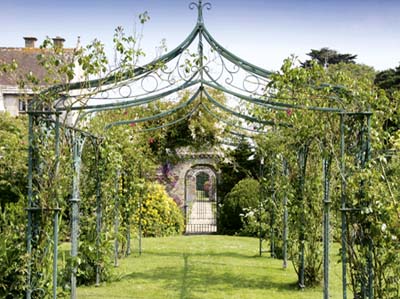Selling your house: What to do in the garden
Start thinking about your garden now if you’re looking to sell your house in September or early 2015


In September, the weather is often very good. Frequently, there are long days of sunshine and the light is softer than that of summer. There is a richness in September (and often well into October) with the new season not yet marred by autumn's gusty winds or flower-chilling cold weather.
Planting good-sized herbaceous plants into flower borders now will give them a whole growing season. If you're not much of a gardener, choose easy, relatively slugproof perennials such as Japanese anemones. Anemone x hybrida Honorine Jobert is a peerless white-flowered variety and dependable pink cultivars include pale baby-pink Konigin Charlotte. Prince Henry is a deeper pink or choose September Charm, which says it all.
Slugs also don't bother with penstemons, which are stalwart, easy-care, long-season perennials (especially if you make a point of dead-heading the spent flowers earlier on). Good reds include Garnet and Raven bears jaunty little bells of a gorgeous, deep aubergine. The very fashionable tall eupatoriums grow rapidly through the season and usually stand up well except in windy areas (where staking is often required).
Still thinking about perennials, when dangers of frost have passed, there are numerous fast-growing salvias, including dark-purple Amistad. Garden centres will be selling them from May or June or visit a Salvia specialist nursery such as Dyson's, in Kent. Heleniums and achilleas are also stal- warts for jolly colour in the late border.
Well-planted and well-positioned pots can have a huge impact. Classic hydrangeas make splendid pot specimens (beware-as their name suggests, they need lots of watering). Look in the greenhouse/conservatory department of garden centres from mid to late May for things such as heliotropes, hibiscuses, marguerites, fuchsias, ginger lilies and eucomises, all of which will put on fast growth over the summer in time for autumn viewing. Pots need to look generous (oversized pots always look better than undersized ones).
Big, leafy subjects can make a tremendously favourable impression-but, again, their good effect will be entirely reliant on your remembering to water them regularly throughout the growing season. Really showy, late-flowering lilies, such as Lilium auratum, L. formosanum and L. henryi are great plants for pots (buy bulbs now from an online bulb specialist and plant them straight away). (Note that potted lilies are also very good for ‘dropping in' among garden plants in a border to give a temporary lift in areas lacking a bit of pizzazz.)
Dahlias are now very fashionable and undeniably showy for the September garden, but be warned: they're prima donnas, only suitable for the committed gardener who is prepared to fuss over them daily. When choosing plants, because you will be needing fairly rapid impact, do go for plants of decent size, such as perennials in two-litre or three-litre nursery pots, not tiny little things that will take ages to grow. Be aware of the plants' needs as to sun or shade and soil conditions. If you feel you need more oomph in the tree and shrub department, these days, there are numerous special- ist nurseries across the country selling mature and semi-mature specimens for instant effect, which a quick online trawl via a search engine will reveal.
Exquisite houses, the beauty of Nature, and how to get the most from your life, straight to your inbox.

Looking ahead, if you're expecting to put your house on the market next spring, it's not too soon to be thinking about how well the garden will be looking. Spring-flowering shrubs are uplifting at this time of uncertain weather and many of them have terrific scent, but don't expect a great deal of growth within a single year. In addition, consider the value of evergreens, such as large-specimen camellias. They're expensive because they're slow-growing, but, planted into decent-sized pots (in ericaceous compost), their impact may well repay the substantial outlay. And, being potted, you can take them with you. But the most obvious quick-fix measure will be to plant lots of bulbs when autumn arrives.
Catalogues from bulb merchants come out at about Chelsea Flower Show time, in mid May, so orders placed then will give the best choice (and, of course, they all have websites). There is some leeway, but daffodils should ideally be planted in August and September; tulips in October or November.
Depending on the size of area you want to transform, think of planting your bulbs in hundreds-and perhaps thousands. Bring in outside help to do it if necessary, then sit back and wait. When they all emerge in their pristine beauty, you might even wonder why you ever wanted to sell.
* Subscribe to Country Life and save
* Follow Country Life magazine on Twitter
Country Life is unlike any other magazine: the only glossy weekly on the newsstand and the only magazine that has been guest-edited by His Majesty The King not once, but twice. It is a celebration of modern rural life and all its diverse joys and pleasures — that was first published in Queen Victoria's Diamond Jubilee year. Our eclectic mixture of witty and informative content — from the most up-to-date property news and commentary and a coveted glimpse inside some of the UK's best houses and gardens, to gardening, the arts and interior design, written by experts in their field — still cannot be found in print or online, anywhere else.

